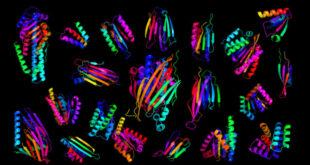Dr. Jonathan Betts from the University of Surrey and colleagues have found that the green-tea polyphenol epigallocatechin gallate (EGCG) can restore the activity of aztreonam, an antibiotic commonly used to treat infections caused by Pseudomonas aeruginosa, a Gram-negative pathogen that is intrinsically multidrug-resistant and frequently associated with healthcare-associated outbreaks.
Epigallocatechin gallate is a compound found in green tea leaves. Image credit: Ranjith Siji.
Pseudomonas aeruginosa is associated with serious respiratory tract and bloodstream infections and in recent years has become resistant to many major classes of antibiotics.
Currently a combination of antibiotics is used to fight Pseudomonas aeruginosa. However, these infections are becoming increasingly difficult to treat, as resistance to last line antibiotics is being observed.
To assess the synergy of EGCG and aztreonam, Dr. Betts and co-authors conducted in vitro tests to analyse how they interacted with Pseudomonas aeruginosa, individually and in combination.
They found that the combination of aztreonam and EGCG was significantly more effective at reducing Pseudomonas aeruginosa numbers than either agent alone.
This synergistic activity was also confirmed in vivo using Galleria mellonella, with survival rates being significantly higher in those treated with the combination than those treated with EGCG or aztreonam alone.
Furthermore, minimal to no toxicity was observed in human skin cells and in Galleria mellonella larvae.
The researchers believe that in Pseudomonas aeruginosa, EGCG may facilitate increased uptake of aztreonam by increasing permeability in the bacteria. Another potential mechanism is EGCG’s interference with a biochemical pathway linked to antibiotic susceptibility.
“Antimicrobial resistance (AMR) is a serious threat to global public health. Without effective antibiotics, the success of medical treatments will be compromised,” Dr. Betts said.
“We urgently need to develop novel antibiotics in the fight against AMR.”
“Natural products such as EGCG, used in combination with currently licenced antibiotics, may be a way of improving their effectiveness and clinically useful lifespan.”
“The World Health Organisation has listed antibiotic resistant Pseudomonas aeruginosa as a critical threat to human health,” said University of Surrey’s Professor Roberto La Ragione.
“We have shown that we can successfully eliminate such threats with the use of natural products, in combination with antibiotics already in use.”
“Further development of these alternatives to antibiotics may allow them to be used in clinical settings in the future.”
The results were published in the Journal of Medical Microbiology.
_____
Jonathan W. Betts et al. Restoring the activity of the antibiotic aztreonam using the polyphenol epigallocatechin gallate (EGCG) against multidrug-resistant clinical isolates of Pseudomonas aeruginosa. Journal of Medical Microbiology, published online August 16, 2019; doi: 10.1099/jmm.0.001060
 #Bizwhiznetwork.com Innovation ΛI |Technology News
#Bizwhiznetwork.com Innovation ΛI |Technology News




